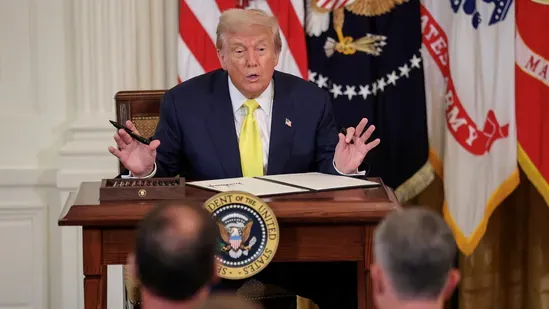Trump’s $2,000 Tariff Dividend: Will Americans Actually Get Paid in November 2025?

Are Americans Getting a $2,000 Tariff Dividend in November? What’s Real and What’s Rumor
As November 2025 unfolds, many Americans have been wondering whether a new round of stimulus-style payments is on the way. The speculation began after President Donald Trump promised a $2,000 “tariff dividend” for Americans. Soon after, social media exploded with claims that checks might land this month.
But despite the buzz, there’s one crucial fact: no payments have been approved.
The Internal Revenue Service (IRS) has stepped in to clear the air, confirming that no new federal checks, relief payments, or automatic distributions are coming in November. According to fact-checkers, Congress has not passed any legislation authorizing a new stimulus, and the IRS has not announced any such program.
Still, Trump’s announcement continues to fuel discussion about what could happen in the future. Here’s a clear breakdown of where the plan stands, why the rumors spread, and what beneficiaries should know moving forward.
Trump’s $2,000 Tariff Dividend Promise
What the President Announced
Earlier this month, President Trump sparked national debate by renewing his push for a tariff-funded payment to Americans. Speaking on Truth Social, he said the United States was collecting massive revenue from tariffs and suggested that the money could be returned to the public.
In his statement, Trump promised a payment of at least $2,000 per person, excluding high-income individuals. He argued that tariff revenues were pouring into the economy and that the government would soon begin paying down its large national debt.
The idea, at its core: instead of traditional stimulus checks from government spending, this would be a “dividend” funded by tariff revenue.
Why the Promise Went Viral
Almost immediately, social media users began comparing Trump’s proposal to COVID-19 stimulus checks. A number of viral posts claimed that payments were already approved or scheduled for November. Many of these posts were shared with no context, leading to widespread confusion.
This comparison, paired with memories of previous stimulus rollouts, made some Americans believe a check was coming soon.
But the reality is more complicated.
No Checks Approved: What the IRS Has Confirmed
The IRS has officially clarified that there are no new federal payments on the way. No legislation has been passed. No program has been authorized. And no timeline has been announced.
The agency issued a warning through multiple outlets emphasizing that misinformation online was fueling unrealistic expectations. It also cautioned Americans about scam messages pretending to be IRS notifications about “new stimulus” programs.
These scams often attempt to steal personal information such as Social Security numbers, bank details, or tax IDs. The IRS stressed that it does not initiate contact through random emails, texts, or social media messages.
How Much Would a Tariff Dividend Cost?
While the plan has not been approved, economists have already analyzed what it might take to turn it into a nationwide program.
One estimate suggests that giving every eligible American a $2,000 payment would cost around $600 billion per year. That number raises major questions about long-term feasibility, even if funded through tariff revenue.
This cost estimate partly explains why no formal action has been taken. For now, the “tariff dividend” remains a proposal, not a policy.
Why Social Media Rumors Spread So Fast
Mistaken comparison to COVID-19 stimulus
The pandemic-era stimulus checks set a precedent in which financial relief arrived quickly and unexpectedly for millions. Since then, any announcement involving money, relief, or dividends tends to spark speculation.
Viral misinformation
A single post claiming that checks were being issued in November gained massive traction across platforms. Even without proof, it created a chain reaction of reposts and discussions.
Lack of official updates from government
When people don’t hear direct clarification from the government, confusion fills the gap. That is why the IRS eventually stepped in to halt the spread of false claims.
Could a Tariff Dividend Happen in the Future?
It’s possible that the administration may push legislation forward, but at this moment, nothing has been submitted to Congress. And without congressional approval, the IRS cannot distribute any payments.
Trump’s message suggests he intends to deliver some form of tariff-based benefit, but details are unclear. Key questions remain unanswered:
- Who qualifies as a “high-income” earner?
- How often would dividends be paid?
- How would the government ensure enough revenue to sustain such payouts?
- When might Congress begin considering a formal bill?
Until these questions are resolved through official channels, the proposal remains a concept.
What Americans Should Do Now
Stay informed through official government sources
The IRS advises people to verify any stimulus-related communication through:
- IRS.gov
- U.S. Treasury Department
- Official government press releases
These are the only trusted sources for updates regarding federal payments.
Be alert for scams
Criminals often use periods of uncertainty to send fake emails or texts offering “early access” to payments. Any message asking for:
- Bank account information
- Social Security number
- Upfront processing fees
- Passwords
is a red flag.
Keep tax information updated
While no payments are available now, staying current with tax filings is essential. If any future federal payment program launches, eligibility will likely depend on recent tax returns.
The Bottom Line: No $2,000 Payments Yet
Despite the excitement surrounding Trump’s tariff dividend announcement, Americans should know that no federal payments are coming in November. Congress has not approved the plan, the IRS has not announced any program, and any messages suggesting otherwise are likely scams.
The proposal, while widely discussed, remains only that: a proposal. Whether it becomes a real benefit for Americans depends on legislation, funding, and formal government approval in the months ahead.
Until then, beneficiaries are urged to stay cautious, follow official updates, and avoid falling for misleading claims online.
